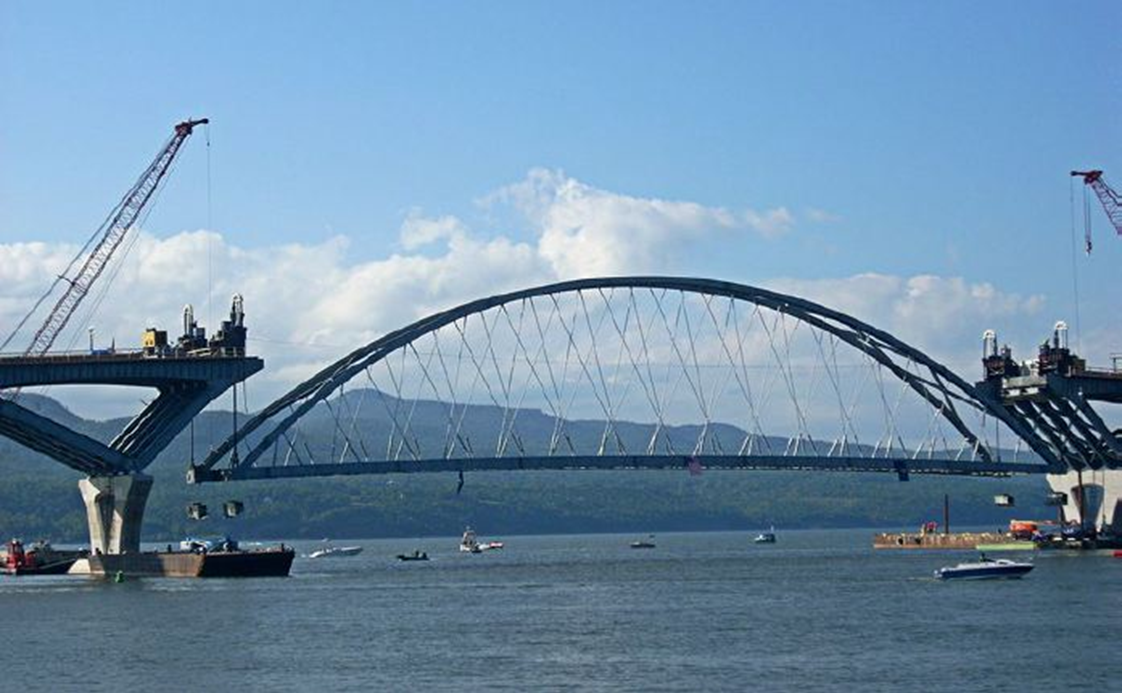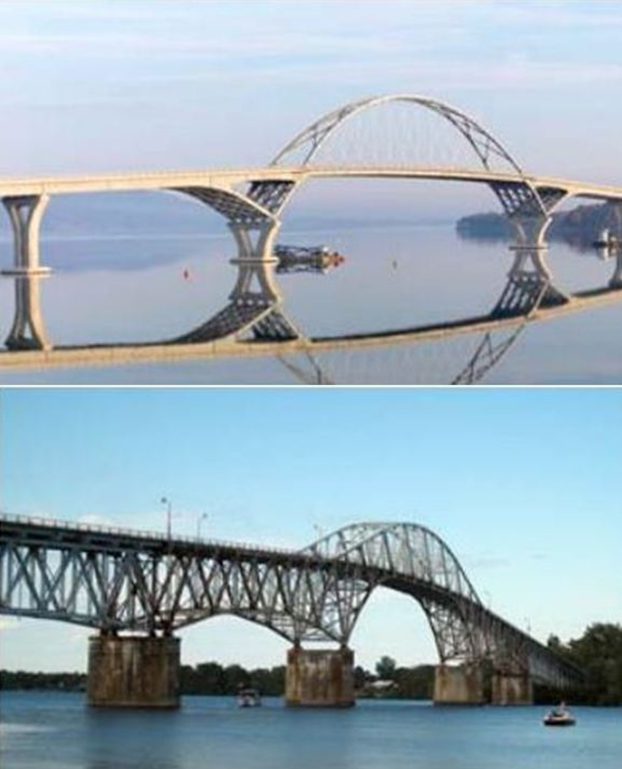
Collaboration Helps to Expedite Lake Champlain Bridge Replacement Project

The new Lake Champlain Bridge, which features a 402-foot arch floated into place over the course of 18 hours, opened to traffic in November 2011.
(Courtesy of NYSDOT)
In October 2009, just weeks after the 80th anniversary of the opening of the Lake Champlain Bridge, the New York State Department of Transportation (NYSDOT) and the Vermont Agency of Transportation (VTrans) had to suddenly close the historic bridge due to the discovery of significant deterioration of its piers. NYSDOT and VTrans worked together with the Federal Highway Administration (FHWA) and many State and local partners to construct a new Lake Champlain Bridge, which opened to traffic ahead of schedule in November 2011, just two years after the closure of the original bridge.
The agencies responsible for the iconic bridge between Chimney Point, Vermont and Crown Point, New York accelerated the project development process for the new bridge because the closure of the bridge caused significant disruption to nearby residents and travelers within the region. Without access to the bridge, which was the only connection between New York and Vermont in the area, drivers faced an 85-mile land detour to reach the opposite side of the lake until the two State DOTs began jointly operating free, temporary ferry service in February 2010. Upon completion of the new bridge, the project team received high praise for its use of partnerships to streamline project delivery, its extensive engagement with the public, and its extraordinary sensitivity to the cultural and historical resources of the region, which comprise thousands of years of human history. In recognition of the exceptional efforts of the partners involved in this project, FHWA honored the project with an Environmental Excellence Award in the category of Cultural and Historical Resources in June 2013.
Partnerships and Collaboration Expedite Project Delivery
Following the abrupt closure of the Lake Champlain Bridge, given its precarious condition and the strong need for a new transportation link across the lake, NYSDOT and VTrans decided to demolish and replace the historic structure. The bridge had recently been listed in the National Register of Historic Places in recognition of its status as an early American example of continuous truss engineering, in which trusses distribute a bridge’s load across multiple spans. Although there was strong local affection for the original bridge, the lead agencies chose not to repair the bridge as such a reconstruction effort would have been both risky and inordinately expensive. Construction of the new bridge would impact culturally and ecologically sensitive areas in its setting, so the lead agencies worked together to deliver a project that was sensitive to historical and cultural values. Through frequent and direct communication, NYSDOT, VTrans, and FHWA were able to develop close relationships that proved necessary to manage the many complexities of the project.

In response to public input, the lead agencies selected the design option (top) that recalls the original 1929 bridge (bottom). (Courtesy of HNTB)
The agencies’ commitment to a swift and collaborative environmental review and permitting process necessitated the involvement of over 40 partners including State Historic Preservation Offices (SHPOs), State and local resource agencies, private consultants, and various Federal agencies. Coordinating the efforts of so many partners required the establishment of an efficient decisionmaking process, including frequent check-in meetings and tightly scheduled review of environmental permitting. The lead agencies also quickly executed programmatic agreements with both SHPOs to expedite the Section 106 review process, which identified and assessed the impacts that construction activities would have on cultural resources such as adjacent forts and historic sites and the bridge itself. Many other State and Federal resource and regulatory agencies also worked with the lead agencies to efficiently review decisions with impacts to cultural and environmental resources. They closely monitored the demolition of the original bridge, the establishment of the temporary ferry service, and construction of the new bridge to ensure that the impacts of these activities on the ecology of Lake Champlain would be properly avoided, minimized, or mitigated. Ultimately, the collaborative approach to decisionmaking and the streamlined review of cultural and environmental impacts resulted in an environmentally sound product in a relatively short time period.
Highly Responsive Public Engagement
In addition to extraordinary collaboration with numerous agencies and partners, the project team also focused on strong public engagement and support grounded in frequent and transparent communication and rapid response to public input. Because many members of the public felt a personal connection to the original bridge, public input into the construction of its replacement was extraordinarily important. As such, lead agency staff worked closely with a Public Advisory Committee that represented environmentalists, commerce officials, and members of the public and organized frequent informational meetings to keep the public informed of anticipated schedules and progress towards completing the bridge. Staff at NYSDOT and VTrans also sent frequent email updates and responded to public website comments to ensure the consideration of public concerns. To maximize the inclusivity of the project, the project team invited the public to review the proposed bridge designs; more than 3,400 people participated in an online bridge concept preference survey. This highly responsive public involvement effort granted the public an exceptional degree of ownership over the project and ultimately resulted in widespread public approval for the final product.
Sensitivity to Cultural and Historical Resources
Because of strong partnerships and active public involvement, the many agencies involved in the Lake Champlain Bridge Project delivered a final product that respected the cultural and aesthetic value of the original bridge, enhanced understanding of regional heritage, and supported local tourism.
Planners at NYSDOT, VTrans, FHWA, and other partner agencies protected cultural resources likely to be impacted by the bridge construction through archaeological reconnaissance to identify artifacts and resources, and by using state-of-the-practice foundation techniques to minimize the potential impact to underground and underwater resources. In recognition of the aesthetic appeal of the original bridge, the designers of the bridge used visualization tools and worked closely with the historic preservation community to ensure that the new, wider bridge would have no negative visual impacts to the adjacent landscape.
The Lake Champlain Bridge Commemoration Program includes the following cultural resources:
- A resource guide that summarizes the location and content of historic source material available at libraries, archives, government agencies, museums, and private collections;
- Filmed oral history accounts of 22 individuals with connections to the original bridge, including people who attended the opening day celebration in 1929;
- A documentary film that details the history of the bridge, its construction, its significance, and its use;
- A popular history booklet that tells the story of the historic Lake Champlain Bridge and includes photographs, maps, architectural drawings, newspaper accounts, and personal stories;
- A Historic American Engineering Record that describes the structure of the original Lake Champlain Bridge; and
- Interpretative displays, museum exhibits, film shorts, and other materials available at museums and historic sites near the Lake Champlain Bridge.
Work on the new Lake Champlain Bridge not only protected the region’s heritage, but also enriched the public’s understanding of and access to the region’s vast cultural and historical resources. Archaeological efforts revealed rare cultural finds, including a historic French fort and Native American stone tools dating back almost 4,000 years. To mitigate the loss of the historic bridge, several partner agencies convened a Working Group of area historians and preservationists to work collaboratively on a robust commemoration program (see the text box for more information). This innovative program featured a variety of multimedia resources that have improved understanding of the region’s heritage for scholars and the general public alike.
The commemoration program and the wealth of cultural material developed as part of the Lake Champlain Bridge Project have also enhanced the appeal of several local historic sites and museums for tourists. Due in part to the positive attention garnered during the construction of the new bridge, the bridge itself has become a tourist attraction in its own right. The bridge’s sidewalks and bicycle lanes have attracted many pedestrians and bicyclists to the bridge and to its adjacent sites. Finally, work on the bridge and the commemoration program has advanced the idea of a long-desired bi-state park that connects cultural resources on both sides of Lake Champlain.
A Model of Success through Collaboration
From the closure of the Lake Champlain Bridge in 2009 to the opening of its replacement in 2011, the Lake Champlain Bridge Project team demonstrated remarkable commitment to collaboration, communication, streamlining, public involvement, and sensitivity to the cultural and historic importance of the 1929 bridge. The result of their efforts is a new, award-winning bridge that meets the needs of the traveling public, protects the legacy of the original bridge, and expands interest in and awareness of the region’s heritage. Despite the complexity of the project, it was executed ahead of schedule due to the dedication and cooperative spirit of NYSDOT, VTrans, FHWA, and their many partner agencies. Since the completion of the new bridge, NYSDOT and VTrans have used the project as a model for applying streamlining processes to other similar projects. In the case of the Kosciuszko Bridge Project, for example, NYSDOT has employed a similar public involvement approach that includes a Stakeholder Advisory Committee to better engage the community and address public feedback. As transportation agencies turn their attention to the repair and replacement of bridges nationwide, the Lake Champlain Bridge Project serves as an exemplary model for the effective, timely, and sensitive overhaul of the Nation’s transportation infrastructure.
Contact Information
Phillip Eng, P.E.
Chief Engineer
New York State Department of Transportation
(518) 457-4430
phillip.eng@dot.ny.gov
Robert M. Davies
District Engineer
New York Division
Federal Highway Administration
(518) 431-8880
robert.davies@dot.gov
Danny Landry
Project Manager
Vermont Agency of Transportation
(802) 828-3639
dan.landry@state.vt.us
Kenneth Sikora
Program Manager
Vermont Division
Federal Highway Administration
(802) 828-4573
kenneth.sikora@dot.gov
Look What’s New!
- FHWA recently released interim program guidance on the Congestion Mitigation and Air Quality (CMAQ) Improvement Program under the Moving Ahead for Progress in the 21st Century Act. The interim program guidance provides information on the CMAQ Improvement Program, including authorization levels, apportionment changes, program flexibility, eligibility for funding, project selection processes, program administration, annual reporting, and performance management. To read the interim program guidance, click here.
Successes in Stewardship is a Federal Highway Administration newsletter highlighting current environmental streamlining and stewardship practices from around the country. Click here to subscribe to the newsletter, or call 617-494-2092 for more information.

